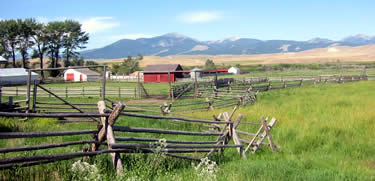
Ranch
A ranch (from Spanish: rancho/Mexican Spanish) is an area of land, including various structures, given primarily to ranching, the practice of raising grazing livestock such as cattle and sheep. It is a subtype of farm. These terms are most often applied to livestock-raising operations in Mexico, the Western United States and Western Canada, though there are ranches in other areas.[1][note 1] People who own or operate a ranch are called ranchers, cattlemen, or stockgrowers. Ranching is also a method used to raise less common livestock such as horses, elk, American bison, ostrich, emu, and alpaca.[2]
This article is about a type of land use and method of raising livestock. For information on people who handle cattle on ranches, see Cowboy. For other uses, see Ranch (disambiguation).
Ranches generally consist of large areas, but may be of nearly any size. In the western United States, many ranches are a combination of privately owned land supplemented by grazing leases on land under the control of the federal Bureau of Land Management or the United States Forest Service. If the ranch includes arable or irrigated land, the ranch may also engage in a limited amount of farming, raising crops for feeding the animals, such as hay and feed grains.[2]
Ranches that cater exclusively to tourists are called guest ranches or, colloquially, "dude ranches". Most working ranches do not cater to guests, though they may allow private hunters or outfitters onto their property to hunt native wildlife. However, in recent years, a few struggling smaller operations have added some dude ranch features such as horseback rides, cattle drives, and guided hunting to bring in additional income. Ranching is part of the iconography of the "Wild West" as seen in Western movies and rodeos.
Origins of ranching[edit]
Ranching and the cowboy tradition originated in Spain, out of the necessity to handle large herds of grazing animals on dry land from horseback. During the Reconquista, members of the Spanish nobility and various military orders received large land grants that the Kingdom of Castile had conquered from the Moors. These landowners were to defend the lands put into their control and could use them for earning revenue. In the process it was found that open-range breeding of sheep and cattle (under the Mesta system) was the most suitable use for vast tracts, particularly in the parts of Spain now known as Castilla-La Mancha, Extremadura and Andalusia.
Ranching in South America[edit]
In Argentina and Uruguay, ranches are known as estancias and in Brazil, they are called fazendas. In much of South America, including Ecuador and Colombia, the term hacienda or finca may be used. Ranchero or Rancho are also generic terms used throughout tropical Latin America.
In the colonial period, from the pampas regions of South America all the way to the Minas Gerais state in Brazil, including the semi-arid pampas of Argentina and the south of Brazil, were often well-suited to ranching, and a tradition developed that largely paralleled that of Mexico and the United States. The gaucho culture of Argentina, Brazil and Uruguay are among the cattle ranching traditions born during the period. However, in the 20th century, cattle raising expanded into less-suitable areas of the Pantanal. Particularly in Brazil, the 20th century marked the rapid growth of deforestation, as rain forest lands were cleared by slash and burn methods that allowed grass to grow for livestock, but also led to the depletion of the land within only a few years. Many of indigenous peoples of the rain forest opposed this form of cattle ranching and protested the forest being burnt down to set up grazing operations and farms. This conflict is still a concern in the region today.